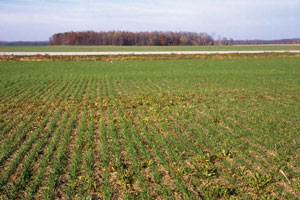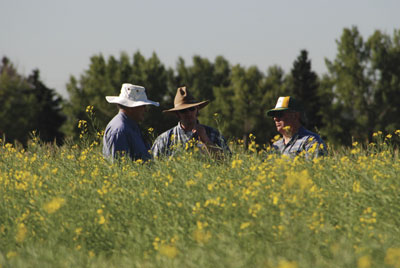
Features
Herbicides
Seed & Chemical
New herbicide first for cereals in two decades
Early results are encouraging so far for a new mode of action for broadleaf weed control in winter wheat and other cereals. Ontario researchers have been putting Infinityrm herbicide from Bayer CropScience to the test as part of a broader evaluation of cereal crop herbicides.
November 14, 2008 By Blair Andrews
Active ingredient impairs plant’s growth abilities.

|
|
| Infinity is suitable for use in wheat, as well as oats and barley. |
Early results are encouraging so far for a new mode of action for broadleaf weed control in winter wheat and other cereals. Ontario researchers have been putting Infinityrm herbicide from Bayer CropScience to the test as part of a broader evaluation of cereal crop herbicides.
The active ingredient in Infinity is pyrasulfotole, a Group 27 herbicide, combined with bromoxynil, a Group 6 herbicide. Greg Good, portfolio manager for row crops with Bayer CropScience, says Infinity is the first new mode of action to be developed for the cereal market in North America for 20 years. “The big thing is they have a synergetic effect when they work together, and that’s really seen on the weeds as it is very fast-acting,” he says. Good goes on to say that Infinity controls many tough broadleaf weeds, including Group 2 resistant weeds.
Infinity is also touted as being very safe on all wheat and barley varieties when applied from the first-leaf stage up to the emergence of the flag leaf. It includes a Bayer CropScience proprietary safe-ner, which works by accelerating the metabolism of the herbicide in the crop but not in susceptible weed species. Once absorbed by the foliage, pyrasulfotole moves through the weed, working in three different ways at the same time to control broadleaf weeds.
The first action stops the weed’s ability to generate an adequate supply of energy. The second action restricts vitamin E production, which protects the weed’s biological membranes against oxidative stresses. The third action prevents carotenoid production, restricting the weed’s protection against ultraviolet rays and excessive light. As a result, the chlorophyll is destroyed, and the plant turns white and dies.
Extensive testing showing positive results
The pyrasulfotole molecule was discovered in Bayer CropScience labs in Frankfurt, Germany through a program aimed at discovering new modes of action. It has been field tested in North America since 2000. Mike Cowbrough, weed management specialist with the Ontario Ministry of Agriculture, Food and Rural Affairs, says a nationwide registration allowed the product to move quickly into the Canadian marketplace in 2007. While Cowbrough says the introduction was positive, a potential downside for eastern growers was that the bulk of the field research was done in western Canada.
Cowbrough, along with University of Guelph researchers Dr. Francois Tardif and Dr. Peter Sikkema, are putting Infinity to the test as a part of a side-by-side evaluation of cereal crop herbicides in 2008. Not only was it an opportunity to study Infinity’s efficacy in Ontario’s environment, the cold days of early May, including a few when there was frost, but it provided an excellent chance to evaluate it from a crop safety perspective. Cowbrough says Infinity seemed to live up to its billing as it fared well under the harsh conditions. “All herbicides caused some sort of crop injury when they were sprayed under adverse conditions, but certainly Infinity was one of the safer options in this year of looking at it from that perspective,” explains Cowbrough.

|
|
| The cumulative effect of blocking nutrients in the weed destroys the chlorophyll, causing the leaves to whiten prior to the plant dying. |
As for weed control or suppression, Infinity exceeded expectations on certain species, with Cowbrough noting he was pleasantly surprised by its activity on dandelions, as well as chickweed. “In terms of general, annual broadleaf weeds, it does a pretty good job,” he says, addding that the new mode of action performed as well as the standard treatments that are in the marketplace, including Refine, Bromoyxnil/MCPA and Dichlorprop/2,4-D.
Cowbrough points out that whenever a product performs well on certain weeds, it may allow weaker ones to surface. In Infinity’s case, the speedwell family of weeds, which are not on Infinity’s label, emerged. Cowbrough says there are five to six different speedwells in Ontario. These are winter annual weeds with small leaves that, according to Cowbrough, escape fairly well.
Another area of Cowbrough’s work revolves around growth room research on herbicides. He uses this work to help find answers to questions producers and agronomists have about some of so-called oddball species of weeds that show up in cereal fields. “Growth room work has its challenges because it is not under field conditions,” concedes Cowbrough. “But the positive is that if a product is not going to control weeds in the growth room, it isn’t going to control weeds out in the fields.”
In Cowbrough’s growth room, he tested Infinity on non-labelled weeds like tufted vetch, field violet and wild carrot species, which Infinity did not control.
Cowbrough’s overall assessment of Infinity in its first year is positive, saying it was a good performer in terms of crop safety and efficacy on the common weeds in Ontario, despite the fact that non-labelled weeds such as speedwells and other obscure weeds are not controlled. He looks forward to analyzing how Infinity and other herbicides perform under different conditions, adding that it takes three to five years to get a good view of a product. And he and others watching Infinity’s progress will have that
opportunity because the University of Guelph research trials are being conducted during the course of several years.
Meanwhile, growers considering Infinity as a weed control option should be aware that it is not to be used on under-seeded legumes. Also, Infinity does not have any tank mixes registered at this time for eastern Canada.